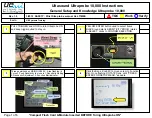
DigitalFlow™ Multipurpose Ultrasonic Liquid Flowmeter Service Manual
25
Chapter 3. Diagnostics
3.4.2 Pipe Problems
Pipe-related problems may result either from a failure to observe the installation instructions, as described in the
Startup Guide
, or from improper programming of the meter. By far, the most common pipe problems are the following:
1. The collection of material at the transducer location(s).
Accumulated debris at the transducer location(s) will interfere with transmission of the ultrasound signals. As a
result, accurate flow rate measurements are not possible. Realignment of the flowcell or transducers often cures
such problems, and in some cases, transducers that protrude into the flow stream may be used. Refer to Chapter 1,
Installation
, of the
Startup Guide
for more details on proper installation practices.
2. Inaccurate pipe measurements.
The accuracy of the flow rate measurements is no better than the accuracy of the programmed pipe dimensions. For
a flowcell supplied by GE, the correct data will be included in the documentation. For other flowcells, measure the
pipe wall thickness and diameter with the same accuracy desired in the flow rate readings. Also, check the pipe for
dents, eccentricity, weld deformity, straightness and other factors that may cause inaccurate readings. Refer to
Chapter 2,
Initial Setup
, of the
Startup Guide
for instructions on programming the pipe data.
In addition to the actual pipe dimensions, the path length (P) and the axial dimension (L), based on the actual
transducer mounting locations, must be accurately programmed into the flowmeter. For a GE flowcell, this data
will be included with the documentation for the system. If the transducers are mounted onto an existing pipe, these
dimensions must be precisely measured. See Appendix D,
Measuring P and L Dimensions
, of the
Startup Guide
for
a thorough discussion of this topic.
3. The inside of the pipe or flowcell must be relatively clean.
Excessive build up of scale, rust or debris will interfere with flow measurement. Generally, a thin coating or a solid
well-adhered build up on the pipe wall will not cause problems. Loose scale and thick coatings (such as tar or oil)
will interfere with ultrasound transmission and may result in incorrect or unreliable measurements.
3.5 Transducer Problems
Ultrasonic transducers are rugged, reliable devices. However, they are subject to physical damage from mishandling
and chemical attack. Clamp-on transducers are also subject to installation variables such as physical misalignment and
faulty coupling to the pipe on which they are mounted.
Because, transducer problems are largely dependent on the type of transducers used, wetted or clamp-on, the following
list of potential problems is grouped according to transducer type. Contact the factory if you cannot solve a
transducer-related problem.
3.5.1 Wetted Transducer Problems
1.
LEAKS:
Leaks may occur around the transducer and/or the flowcell fittings. Repair such leaks immediately. If the
leaking fluid is corrosive, carefully check the transducer and cables for damage, after the leak has been repaired.
2.
CORROSION DAMAGE:
If the transducer material was not properly chosen for the intended application, the
transducers may suffer corrosion damage. The damage usually occurs either at the electrical connector or on the
transducer face. If corrosion is suspected, remove the transducer from the flowcell and carefully inspect the
electrical connector and the transducer face for roughness and/or pitting. Any transducer damaged in this manner
must be replaced. Contact the factory for information on transducers in materials suitable for the application.
Summary of Contents for DigitalFlow DF868
Page 2: ......
Page 4: ...ii no content intended for this page proceed to next page ...
Page 22: ...Chapter 1 Calibration DigitalFlow Multipurpose Ultrasonic Liquid Flowmeter Service Manual 14 ...
Page 64: ......
Page 66: ......
Page 67: ......
















































